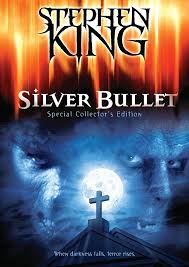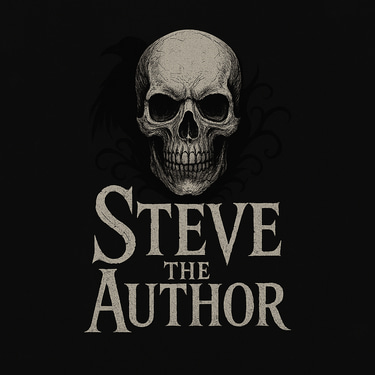Exploring the Dark Realms: Steve's Journey Through Horror and Fantasy
Join Steve the Author as he delves into the captivating worlds of horror and fantasy. Here we will pick a movie or television show and talk about what works with it and why. If its an old movie (spoiler alert, it probably will be) we will discuss if it holds up to time. Discover where I fell in love with horror, fantasy, magic, and the unexpected. Take a walk with me down memory lane, if you dare.
REVIEWS
Steven DeLong
11/1/20253 min read


Stephen King’s Silver Bullet (1985)
A Nostalgic Werewolf Thriller That Still Carries a Bite
Introduction: A Childhood Favorite That Still Howls
Some movies leave claw marks on your childhood memories — Stephen King’s Silver Bullet is one of them. Released in 1985 and based on King’s illustrated novella Cycle of the Werewolf, this film became a cable-TV staple for an entire generation of young horror fans. While it may not be the slickest werewolf picture ever made, the film still carries a strange, comforting charm that makes a rewatch feel like coming home to an old monster under your bed.
As an adult, I can see the seams, the quirks, and the limitations — but childhood me didn’t care. And honestly? A big part of me still doesn’t. That’s why this one earns a solid 3.5 stars.
The Story: Small Town, Big Secrets, and One Determined Kid
Set in the fictional town of Tarker’s Mills, Silver Bullet follows Marty Coslaw (Corey Haim), a wheelchair-bound teen who begins to suspect that a string of gruesome murders are the work of something more sinister than a human killer. With the help of his quick-witted sister (Megan Follows) and his unpredictable, beer-loving Uncle Red (Gary Busey), Marty uncovers the truth: a werewolf is living among them.
The film blends classic monster-movie atmosphere with Stephen King’s signature small-town melancholy. You can practically feel the summer heat and hear the distant hum of cicadas underlining the dread.
The Cast: Heart, Humor, and Unintentional Charm
Corey Haim as Marty Coslaw
Haim delivers one of his most endearing early performances. Even in an action-oriented horror role, he brings sensitivity and determination, helping the audience root for him from the start. His custom-built motorized wheelchair—nicknamed The Silver Bullet—became an iconic piece of 80s horror memorabilia.
Gary Busey as Uncle Red
If Silver Bullet has a soul, Busey provides it. This was Busey before his later larger-than-life reputation, and yet you can already see flashes of that distinct, chaotic energy. Many of his lines were reportedly improvised, giving the film moments of humor and humanity that balance the heavier beats. His scenes with Haim still feel genuine.
Everett McGill as Reverend Lowe
McGill, best known for Twin Peaks, brings an unsettling presence as the troubled Reverend Lowe. His performance walks a tightrope between sympathetic and deeply disturbing — exactly what the role needs.
Megan Follows as Jane Coslaw
Before she became widely known for Anne of Green Gables, Follows played Jane with grounding sincerity. Her narration provides the film’s reflective tone, anchoring it in memory.
Behind the Scenes: The Infamous Werewolf Suit
No discussion of Silver Bullet is complete without mentioning the legendary (and sometimes controversial) werewolf suit.
Designed by Carlo Rambaldi
The creature effects were crafted by Carlo Rambaldi — yes, the same Oscar-winning artist responsible for E.T. the Extra-Terrestrial. Despite his credentials, fans remain split on the design. Rambaldi aimed for a more humanoid, almost gentle-looking werewolf, which clashed with Stephen King’s initial desire for something more feral.
The Werewolf’s Look: Love It or Hate It
The result is a wolf that’s memorable but divisive. Some viewers find it eerie because of its simplicity. Others think it lacks the visceral punch of werewolves seen in An American Werewolf in London or The Howling. Still, it has a unique charm — one that fits the film’s tone and era.
Fun Fact: Hidden Details
The full suit was so warm that McGill could only wear it for short stretches.
Several scenes required stunt performers due to limited mobility in the costume.
The famous church dream sequence used dozens of extras in werewolf suits, creating one of the film’s most visually striking moments.
What Holds Up Today
The Atmosphere
Tarker’s Mills feels like a real town with real secrets. The movie captures that specific brand of 1980s small-town Americana that Stephen King fans love.
The Performances
Haim and Busey give the film its heart. McGill gives it its menace.
The Nostalgia Factor
Even with its flaws, Silver Bullet is incredibly rewatchable. It’s cozy horror — spooky enough to thrill, gentle enough to comfort.
What Shows Its Age
The werewolf suit, while iconic, definitely reflects 1980s practical limitations.
Some pacing issues slow the tension in the middle act.
The narration, while nostalgic, occasionally over-explains the story.
Final Thoughts: A Howling Good Time, Even Decades Later
Silver Bullet may not be the scariest werewolf film ever made, but it’s easily one of the most beloved. The combination of heartfelt performances, earnest storytelling, and charmingly imperfect creature effects gives it staying power.
For me, it was a great movie when I was a kid — and I’ll always remember it that way.
